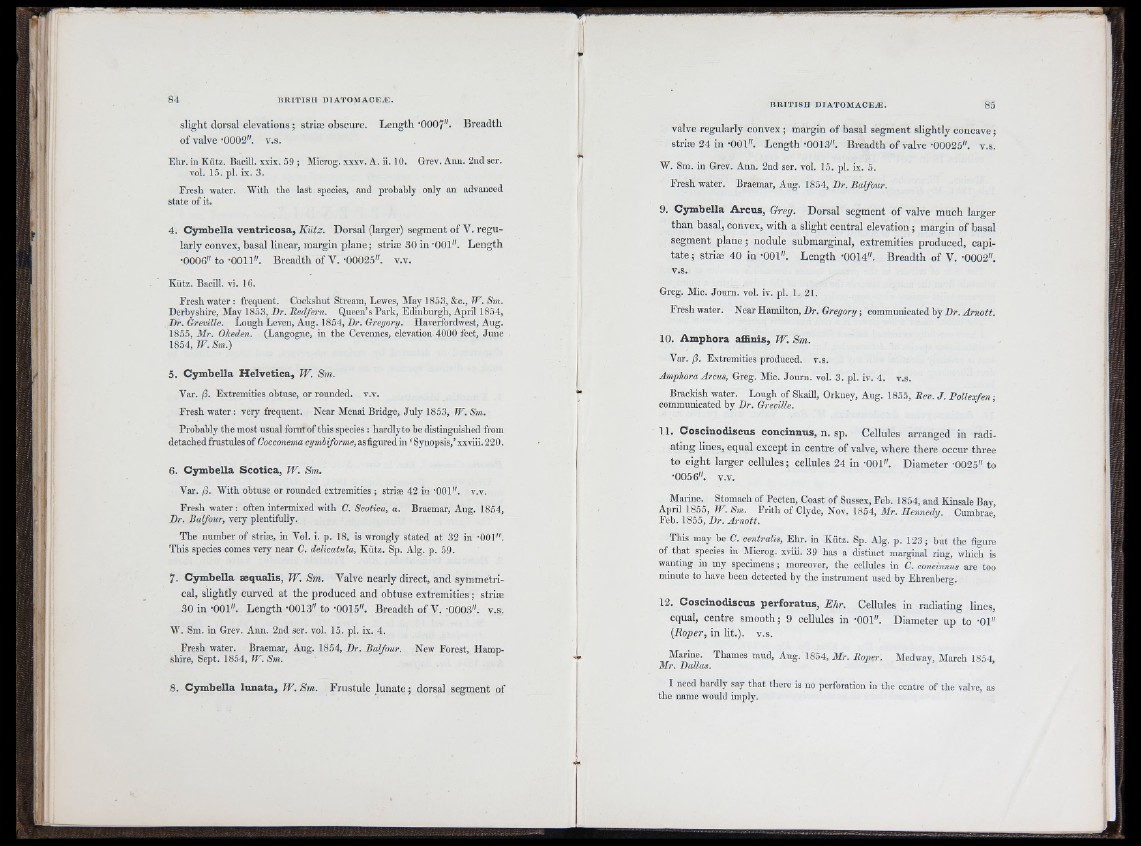
slight dorsal elevations ; striæ obscure. Length 'OOO?". Breadth
of valve •0002". v.s.
Ehr. in Kiitz. Bacill. xxix. 59 ; Microg. xxxv. A. ii. 10. Grev. Ann. 2nd ser.
vol. 15. pl. ix. 3.
Fresh water. With the last species, and probably only an advanced
state of it.
4. Cymbella ventricosa, Kiitz. Dorsal (larger) segment of V. regu-
lai'ly convex, basal linear, margin plane ; striæ 30 in '001". Length
•0006" t o ’OOll". Breadth of V . '00025". v.v.
Kiitz. Bacill. vi. 1C.
Fresh water : frequent. Cockshnt Stream, Lewes, May 1853, &c., W. Sm.
Derbyshire, May 1853, Hr. Redfern. Queen’s Fark, Edinburgh, April 1854,
Hr. Greville. Lough Leven, Aug. 1854, Hr. Gregory. Haverfordwest, Aug.
1855, Mr. Okeden. (Langogne, in the Cevennes, elevation 4000 feet, June
1854, W. Sm.)
5. Cymbella Helvetica, W. Sm.
Var. /3. Extremities obtuse, or rounded, v.v.
Fresh water : very frequent. Near Menai Bridge, July 1853, TF. Sm.
Frobably the most usual form of this species : hardlyto be distinguished from
detached frustules of Cocconema cymbiforme, asfigured in ‘Synopsis,’ xxviii. 220.
6. Cymbella Scotica, W. Sm.
Var. (3. With obtuse or rounded extremities ; striae 42 in -001". v.v.
Fresh water: often intermixed with C. Scotica, a. Braemar, Aug. 1854,
Hr. Balfour, very plentifully.
The number of striæ, in Vol. i. p. 18, is wrongly stated at 32 in -001".
This species comes very near C. delicatula, Kiitz. Sp. Alg. p. 59.
7. Cymbella æqualis, W. Sm. Valve nearly direct, and symmetrical,
slightly curved at the produced and obtuse extremities ; striæ
.30 i n '001". L e n g th -0013" t o -0015". Breadth of V . '0003". v.s.
W. Sm. in Grev. Ann. 2nd ser. vol. 15. pl. ix. 4.
Fresh water. Braemar, Aug. 1854, Hr. Balfour. New Forest, Hampshire,
Sept. 1854, TF. Sm.
8. Cymbella lunata, W .Sm . Frustule lunate; dorsal segment of
valve regularly convex ; margin of basal segment slightly concave ;
striæ 24 i n -001". L e n g th -0013". Breadth of v a lv e -00025". v.s.
W. Sm. in Grev. Ann. 2nd ser. vol. 15. pl. ix. 5.
Fresh water. Braemar, Aug. 1854, Br. Balfour.
9. Cymbella Arcus, Greg. Dorsal segment of valve much larger
than basal, convex, with a slight central elevation ; margin of basal
segment plane; nodule submarginal, extremities produced, capita
te ; striæ 40 in -OOl". Length -0014". Breadth of V. -0002".
Greg. Mic. Journ. vol. iv. pl. 1. 21.
Fresh water. Near Hamilton, Br. Gregory ; communicated by Br. Arnott.
10. Amphora affinis, W. Sm.
Var. ¡3. Extremities produced, v.s.
Amphora Arcus, Greg. Mic. Journ. vol. 3. pl. iv. 4. v.s.
Brackish water. Lough of Skaill, Orkney, Aug. 1855, Rev. J. Pollexfen ;
communicated by Br. Greville.
11. Coscinodiscus concinuus, n. sp. Cellules arranged in radiating
lines, equal except iu centre of valve, where there occur three
to eight larger cellules; cellules 24 in -001". Diameter -0025" to
•0056". v.v.
Marine. Stomach of Pecten, Coast of Sussex, Feb. 1854, and Kinsale Bay,
April 1855, TF. Sm. Frith of Ch'de, Nov. 1854, Mr. Hennedy. Cumbrae
Feb. 1855, Br. Arnott.
This may be C. centralis, Ehr. in Kutz. Sp. Alg. p. 123; but the figure
of that species in Microg. xviii. 39 has a distinct marginal ring, which is
wanting in my specimens ; moreover, the cellules in C. concinnus are too
minute to have beeu detected by the instrument used by Ehrenberg.
12. Coscinodiscus perforatus, Ehr. Cellules in radiating lines,
equal, centre smooth ; 9 cellules in -OOl". Diameter up to -01"
{Roper, in lit.), v.s.
Marine. Thames mud, Aug. 1854, Mr. Roper. Medwav, Marcii 1854,
Mr. Balias.
I need hardly say that there is no perforation in the centre of the valve, as
the name would imply.